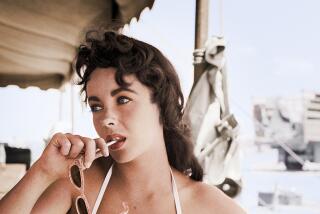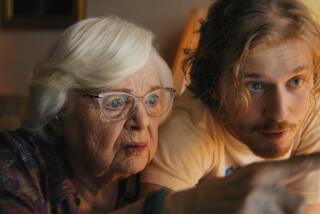Women in Films: Age of Anxiety : Movies: While men age gracefully, older women are portrayed as background furniture, says a new study.
BOSTON â Older women portrayed in film remain largely stereotyped as âhags, nags, witches or worse,â a new study by a pair of Boston researchers has found.
âItâs interactive,â said Elizabeth Markson, a Boston University sociologist who is associate director of the universityâs Gerontology Institute. âI think that film reflects society, and society reflects film.â
âMen in the movies who get older are seen as distinguished. Women are seen as old,â said Watertown, Mass., psychotherapist Carol Taylor, Marksonâs collaborator on âInterpretations of Older Women in Film: A Sociological/Psychological Analysis.â The two researchers will present the paper today at Boston University.
As stars, Taylor said, âyou may have one or two women per decadeâ who are over the age of 60. Otherwise, âolder women in films are pretty much treated like background furniture,â she said.
By contrast, Taylor said, âwe noticed just how many male actors there are who make films right up to when they die.â
Taylor and Markson said their research stemmed in part from a curiosity they felt about the âslewâ of films featuring older women in prominent roles that came out in the 1980s.
But further examination showed them that the slew turned out to be four films, âOn Golden Pond,â âDriving Miss Daisy,â âWhales of Augustâ and âThe Trip to Bountiful.â
A computer comparison of ages of Academy Award winners for best actor and best actress showed âabout a 10-year age difference,â Markson said. Men who earned the best actor award averaged around 45 years of age, she found. Their female counterparts were closer to 35.
âIn some ways we were confirming what our eyes had already noticed,â Markson said. âIn part we were testing whether our eyes were correct.â With âsomething less than a 1 in 1,000 possibilityâ that their results were due to chance, âwe found that yes, indeed, our eyes were correct,â Markson said.
As a further element in their âmen versus womenâ comparison, âmost of the differences in the women is due to what we call the Hepburn-Tandy effect,â Markson said--âin other words, the ability of one or two female stars to surviveâ and to continue acting.
Katharine Hepburn, she noted, âshows up as an Academy Award winner just about every decade. With men, it seems to be more random.â
Only Marie Dressler, who won the best actress award in 1932 for âMin and Bill,â skews that equation, Markson said. âIf we take her out, then we have nobodyâ other than Katharine Hepburn or Jessica Tandy winning the best actress award over the age of 60.
âI think this shows that the double standard falls most heavily on older women,â said New York writer Molly Haskell, author of âFrom Reverence to Rape: The Treatment of Women in Moviesâ (University of Chicago Press).
âI think one thing youâve got to realize is that the standards of physical beauty are much more rigid when applied to women than to men,â Haskell said.
Markson pointed out that the representation--or as she prefers to think of it, misrepresentation--of older women in films is also affected by the roles to which they are constrained. When given significant roles, she said, âolder women are typically cast as figures who exist to support the activities of men or families.â Like Hepburn in âOn Golden Pond,â âthey are the mediators,â Markson said.
Alternatively, older women may still be seen in the mold of 50-year-old Gloria Swanson in 1950âs âSunset Boulevard,â as âa spider woman, entrapping the young man,â Markson said.
Finally, there is the âless attractive, less desirable, opinionated and eccentricâ older woman, the âold bag,â Markson said, who is typified by Geraldine Page in âThe Trip to Bountifulâ or, more dramatically still, by Jessica Tandyâs role in âDriving Miss Daisy.â
âShe proves her incompetence in the very first scene when she backs the car off the road,â Markson said.
She speculated that this narrow characterization of women can be traced to the fact that âby and large, when older women are portrayed, it is primarily through male eyes.
âAgain, this is a reflection of society as a whole,â Markson added. âIt is not unique to the film industry.â
But filmâs pigeonholing of older women probably is more pronounced because of the relative dearth of female directors, Markson said. She noted that Lena Wertmuller, for the 1975 film âSeven Beauties,â is the only woman to have been nominated for the Academy Award for best director, âand she lost to the guy (John G. Avildsen) who directed âRocky.â â
Even in the latest round of Oscars, Markson said, Penny Marshallâs film âAwakeningsâ was nominated in best picture, best actor and best screenplay categories, but Marshall failed to win a nomination for director.
Markson and Taylor said that while welcoming the critical and box-office success of a movie like âThelma & Louise,â which focuses on the relationship of two women, they were troubled by the lack of an appropriate vocabulary to describe this type of movie.
âWeâre stuck with calling them âbuddy filmsâ â itself a male term, Taylor said.
But Haskell said she was heartened that the climate in Hollywood today could support a movie with a pair of female protagonists who are over the age of 22.
âItâs really amazing. Something like âThelma & Louiseâ could not have been made even five years ago,â she said.
More to Read
Only good movies
Get the Indie Focus newsletter, Mark Olsen's weekly guide to the world of cinema.
You may occasionally receive promotional content from the Los Angeles Times.










